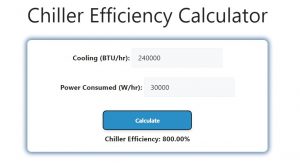About Chiller Efficiency Calculator (Formula)
A Chiller Efficiency Calculator helps measure the efficiency of a cooling system by determining how well it converts electrical power into cooling output. Chillers are widely used in industries for air conditioning and refrigeration, and their efficiency plays a critical role in energy management. Calculating chiller efficiency enables you to assess the system’s performance and optimize energy usage.
Formula
The formula to calculate chiller efficiency is:
Chiller Efficiency (Echill) = (Cooling BTU/hr) / (Power Consumed W/hr) * 100
Where:
- Cooling (BTU/hr): The amount of heat the chiller removes from the environment per hour, measured in British Thermal Units (BTU).
- Power Consumed (W/hr): The electrical energy consumed by the chiller per hour, measured in watts (W).
How to Use
To use the Chiller Efficiency Calculator, follow these steps:
- Input Cooling (BTU/hr): Enter the amount of cooling provided by the chiller in BTU per hour.
- Input Power Consumed (W/hr): Provide the power consumption of the chiller in watts per hour.
- Click Calculate: Press the “Calculate” button to compute the chiller’s efficiency.
- View the Result: The result will show the chiller efficiency as a percentage, indicating how effectively the chiller is converting energy into cooling.
Example
Consider a chiller that provides 240,000 BTU/hr of cooling and consumes 30,000 W/hr of power. Using the formula:
Chiller Efficiency = (240,000 / 30,000) * 100
Chiller Efficiency = 8 * 100
Chiller Efficiency = 800%
This means the chiller is operating at 800% efficiency, which indicates how well it is utilizing electrical energy to provide cooling.

FAQs
- What is chiller efficiency?
Chiller efficiency measures how effectively a chiller converts electrical energy into cooling output, typically expressed as a percentage. - Why is chiller efficiency important?
Efficient chillers consume less energy to provide the same amount of cooling, leading to reduced operational costs and lower environmental impact. - What factors affect chiller efficiency?
Factors include maintenance, load conditions, water flow rates, refrigerant levels, and ambient temperature. - What is a good chiller efficiency percentage?
A chiller efficiency between 400% and 800% is considered good, but it depends on the chiller type and application. - How do I increase chiller efficiency?
Regular maintenance, optimizing cooling loads, using variable speed drives, and maintaining proper water flow can help improve efficiency. - What is BTU/hr in chiller calculations?
BTU/hr refers to British Thermal Units per hour and is a measure of the amount of heat removed by the chiller. - How does power consumption affect chiller efficiency?
Higher power consumption without a corresponding increase in cooling capacity reduces efficiency, leading to higher operational costs. - Can chiller efficiency be above 100%?
Yes, because the efficiency ratio compares cooling output (BTU/hr) to electrical energy input (W/hr), not an energy conversion percentage. - What is the difference between chiller efficiency and COP?
COP (Coefficient of Performance) is a different measure, comparing cooling output in watts to power input in watts, while chiller efficiency uses BTU/hr and watts/hr. - How often should I check chiller efficiency?
Regularly check efficiency, especially after maintenance or system changes, to ensure optimal performance. - What role does refrigerant play in chiller efficiency?
Proper refrigerant levels are crucial for efficient heat transfer and maintaining optimal chiller efficiency. - What is the impact of ambient temperature on chiller efficiency?
Higher ambient temperatures can reduce chiller efficiency, as the system has to work harder to provide cooling. - How does maintenance affect chiller efficiency?
Regular maintenance, including cleaning coils and checking for leaks, can significantly improve chiller efficiency. - Can chiller efficiency decrease over time?
Yes, efficiency can decrease due to wear and tear, refrigerant leaks, or inefficient components, requiring timely maintenance. - What are the signs of poor chiller efficiency?
Increased energy bills, reduced cooling performance, and excessive wear on components may indicate poor chiller efficiency. - How can variable speed drives improve chiller efficiency?
Variable speed drives adjust the motor speed based on the cooling load, reducing power consumption and improving efficiency. - Is chiller efficiency the same for all types of chillers?
No, different types of chillers (air-cooled, water-cooled) have varying efficiency levels based on design and application. - What is the environmental impact of efficient chillers?
Efficient chillers reduce energy consumption, leading to lower greenhouse gas emissions and a smaller carbon footprint. - How does water flow rate affect chiller efficiency?
Incorrect water flow rates can reduce heat exchange efficiency, leading to lower overall chiller performance. - Can chiller efficiency be improved with technology upgrades?
Yes, upgrading to newer, more efficient components like compressors and controls can boost chiller efficiency.
Conclusion
The Chiller Efficiency Calculator is a valuable tool for evaluating how effectively your cooling system operates. By calculating chiller efficiency, you can optimize energy usage, reduce costs, and enhance performance. Regular monitoring and maintenance, along with energy-efficient practices, ensure that your chiller runs at peak efficiency, saving both energy and money.
